- eISSN 2353-8414
- Tel.: +48 22 846 00 11 wew. 249
- E-mail: minib@ilot.lukasiewicz.gov.pl
Wirtualizacja zachowań konsumentów usług w Polsce – perspektywa postpandemiczna
Barbara Kucharska1, Mirosława Malinowska2
1,2 Faculty of Economics, Department of Market and Consumption, University of Economics in Katowice, 1 Maja 47, 40-287 Katowice, Poland
1E-mail: barbara.kucharska@ue.katowice.pl
ORCID: 0000-0003-0669-3330
2E-mail: miroslawa.malinowska@ue.katowice.pl
ORCID: 0000-0001-7467-2502
DOI: 10.2478/minib-2024-0018
Abstrakt:
Wirtualizacja zachowań konsumentów, intensyfikowana przez pandemię COVID-19, znacząco wpłynęła na sektor usług w Polsce. Pandemia przyspieszyła adaptację wirtualnych rozwiązań w wielu branżach, w tym turystyce, gastronomii, kulturze, edukacji oraz opiece zdrowotnej. Artykuł rozpoczyna od przedstawienia integracji rozwiązań cyfrowych w różnych sektorach usługowych, analizując ich wpływ na zachowania konsumentów i sposób świadczenia usług. Opierając się na ankiecie internetowej przeprowadzonej w listopadzie 2022 roku na próbie 1100 respondentów, których profil społeczno-demograficzny odpowiada cechom Polaków korzystających z Internetu (panel Ariadna), artykuł bada percepcje konsumentów oraz efektywność transformacji cyfrowej w trakcie pandemii. Wyniki wskazują, że polscy konsumenci pozytywnie ocenili rozwiązania wirtualne, które ułatwiły dostęp do usług podczas okresu ograniczeń. Niemniej jednak, gotowość do kontynuacji wykorzystywania tych rozwiązań w rzeczywistości postpandemicznej jest selektywna, ze szczególnym preferowaniem rozwiązań w obszarach administracji, dostawy jedzenia oraz telemedycyny, podczas gdy zainteresowanie wirtualnymi usługami kulturalnymi pozostaje ograniczone. Badanie podkreśla znaczenie potrzeby i postępu technologicznego w kształtowaniu nowoczesnych interakcji konsumentów z sektorem usług, sugerując trwałe, ale selektywne, przyszłe wykorzystanie usług wirtualnych po pandemii.
MINIB, 2024, Vol. 53, Issue 4
DOI: 10.2478/minib-2024-0018
Str. 98-118
Opublikowano 12 września 2024

Wirtualizacja zachowań konsumentów usług w Polsce – perspektywa postpandemiczna
1. Introduction
The increasing digitization of society, along with the dynamic expansion of the online realm, has profoundly influenced consumer behaviors – altering their perception of distance across space and time, enhancing the availability of goods and services (including new digital products), and reshaping communication in both personal life and business (Zalega, 2017). The term “virtualization” refers to the growing infusion of Internet technologies into socioeconomic life, accompanied by an increase in the number of users spending more time on various online activities (Grybś-Kabocik, 2017). Virtualization is linked to the rapid and extensive development of information and communication technologies, enabling the use of virtual solutions across economic, social, cultural, and educational sectors. The COVID-19 pandemic further accelerated organizations’ adoption of virtual solutions, seeking to mitigate or negate the adverse impacts of the pandemic restrictions, particularly the need for social distancing or outright bans on employee–customer interactions. Consequently, this hastened the pace and expanded the scope of consumer behavior virtualization. However, to what extent can these changes be expected to remain in force post-pandemic?
This paper is organized as follows: it first outlines the integration of digital solutions into various sectors, emphasizing the role of the COVID-19 pandemic in accelerating digital adoption and its implications for future service delivery and consumer engagement. Next, based on a literature review, it details the evolution of virtualization in consumer behavior across services, including gastronomy, tourism, cultural, educational, and medical sectors. The paper then reports and analyzes the results of an online survey regarding virtualized services in Poland during and after the COVID-19 pandemic.
In the realm of service consumption, virtualization is reshaping existing consumer behaviors and fostering new ones. This primarily manifests itself as the individualization and democratization of cultural content consumption – consumers can freely select content according to their preferences, or even create it themselves. Other aspects include the merging of real and virtual lives, and shifts in the locations and timings for fulfilling needs – from institutions to homes, and at consumer-chosen times (Bywalec, 2010, pp. 223–226; Kowalska, 2015, pp. 65–66).
The virtualization of consumer behaviors involves satisfying needs via electronic communications, especially over the Internet (Grybś-Kabocik, 2017; Kowalska, 2015). Behaviors are increasingly being transferred to cyberspace, where they occur at times convenient for consumers. This includes using desktop computers, laptops, and mobile devices (smartphones, tablets) to access the Internet to search for ideas, gather inspiration, obtain information about services and their providers, check service availability and conditions, compare prices and offers, seek opinions from other consumers and experts, take advantage of promotional offers, and share feedback (Kucharska, 2015, pp. 40–45).
Information and communication technologies provide open access to extensive information about services and sometimes enable their remote consumption. Barriers existing in physical spaces, such as distance, travel difficulties, time constraints of travel and service hours, and occasionally psychological barriers (e.g., stemming from pressure by personnel providing services or handling customer service) are reduced or removed. The widespread adoption of the Internet has led to the erasure of traditional distinctions in the consumer’s life between day and night, weekdays and weekends, home and work, or leisure and labor (Urry, 2009, pp. 179–180).
Virtualization offers significant flexibility in content consumption. The online space enables consumers to share experiences, stimulating changes and fostering the adoption of new purchasing behaviors while displacing products that fail to meet consumer expectations. The Internet not only aids in organizing consumers’ daily lives by reducing mobility and communication barriers and providing easy access to offerings, but also influences the entire purchasing decision-making process, from need stimulation to post-purchase behaviors (Zalega, 2017).
The ongoing virtualization of consumer behaviors in the service market is shaped by numerous factors. Among these, technological factors are especially pivotal as they enable the use of service providers’ offerings online – this includes the widespread use of mobile apps without time or location restrictions, enhanced Internet connection quality, the use of GSM technology for online delivery tracking, and the improved quality of devices that facilitate the use of information and communications technology (ICT) solutions. Sociocultural changes also promote the virtualization of consumer behaviors; these encompass a fast-paced lifestyle combined with a scarcity of time, a preference for convenient and rapid satisfaction of needs, expectations for immediate problem resolution, and an increasing focus on home-centric living and “cocooning” (Strzębicki, 2020, pp. 59–71).
The expansion and intensification of virtualization in service-consumer behaviors is also driven by the rising importance of generations for whom the online environment is primary – mainly Generations Y, Z, and Alpha, who spend much of their lives in a seamlessly integrated offline and online world. Older generations, however, cannot be overlooked. The segment of individuals over 50 years old, the largest consumer group globally, is notably demanding, focusing on health, well-being, and appearance as they embrace a new life stage without adult children and pursue their own passions (Włodarczyk, 2022, p. 10). Technological advancements have impacted all consumer generations (Łopacińska, 2021, p. 37), evolving them from “naive” analog-era clients to well-informed consumers continually connected online. Depending on their needs and digital skill levels, consumers may find themselves at different stages of this evolution, potentially moving to higher levels (increased reliance on digital technologies and the Internet) or lower ones (reduced online activity). Notably, the analog-digital consumer (integrating daily activities online), the digital consumer (using the Internet as a primary environment for life and work), and the “comsumer” (a blend of “communicator” and “consumer”) are crucial in the virtualization of consumer behaviors (Kowalska, 2023, pp. 97–98).
The Internet not only enhances access to information about services but also creates new opportunities to utilize these services, such as eliminating intermediaries and personalizing services (Tarapata & Krzepicka, 2018, pp. 93–106). The broadening array of e-services enables a wider audience to access them, especially those facing restrictions or high costs in accessing physical services. Consumers can manage various aspects of their personal, professional, and household lives without leaving home, fulfilling needs privately that were once public, such as watching movies, theater performances, or concerts at home (Zalega, 2017).
Without a doubt, the COVID-19 pandemic significantly influenced the growth and scope of service-consumer behavior virtualization. It sped up the development and adoption of online service solutions and encouraged consumers to embrace these technologies more swiftly. Pandemic-related movement restrictions, social distancing requirements, and infection concerns particularly disrupted the service sector. Restrictions severely affected services requiring direct customer contact, such as healthcare, gastronomy, hospitality, tourism, transport, and cultural sectors. Additionally, the pandemic spurred the development of services reliant on modern information and computing technologies, leading to their virtualization. The demand for electronic services, such as e-commerce and remote education, increased. Opportunities for using services traditionally offered only in-person expanded to include virtual options (Dominiak, 2022, pp. 129–134).
According to expert forecasts (Deloitte, 2020), a number of factors may influence the future of the global economy and thus the development of services and the level of market entities’ virtualization behaviors in the post-pandemic reality – particularly those associated with new technologies (automation, digitization, cloud technology, technologization of healthcare) and social changes (a new generation of workers, crowdsourcing, sharing economy) (Pluta-Olearnik, 2021, p. 129).
The aim of this study is to investigate how the COVID-19 pandemic has accelerated the virtualization of consumer behaviors within the Polish service sector and to assess consumer attitudes towards ongoing virtual service delivery solutions in the post-pandemic era. This research focuses on identifying which virtual practices are likely to persist, examining sector-specific adoption trends, and understanding the broader implications of these shifts for future service delivery and consumer interaction.
2.Manifestations of consumer behavior virtualization with regard to select services
Initially, the virtualization of consumer behaviors in the service sector was limited to the ability to book appointments, place orders, and process payments online. Over time, as social media have evolved, new opportunities have arisen for sharing information and thus for delivering services in cyberspace. Today, consumers can access a wide range of services virtually, often with the assistance of virtual consultants (Ciechomski, 2023; Zacher, 2013, p. 19; Ahmed et al., 2018, pp. 3211–3213).
The degree of virtualization in consumer behaviors largely depends on the type of services and their specific characteristics. Certain virtual activities are common across many services, such as searching for a service and its availability, reading and writing reviews (particularly via platforms like social media, blogs, microblogs, forums, discussion groups, VoIP, audio/video podcasts), comparing prices and sales terms (using price-comparison aggregators, making online purchases, processing payments, or participating in customer satisfaction surveys). Consumer behaviors differ across various service markets, driven by the unique needs presented and, fundamentally, by the potential for virtual solutions to satisfy these needs. The broad range of virtualization strategies becomes apparent when one examines specific sectors such as gastronomy, tourism, medical, or cultural services (see Table 1).
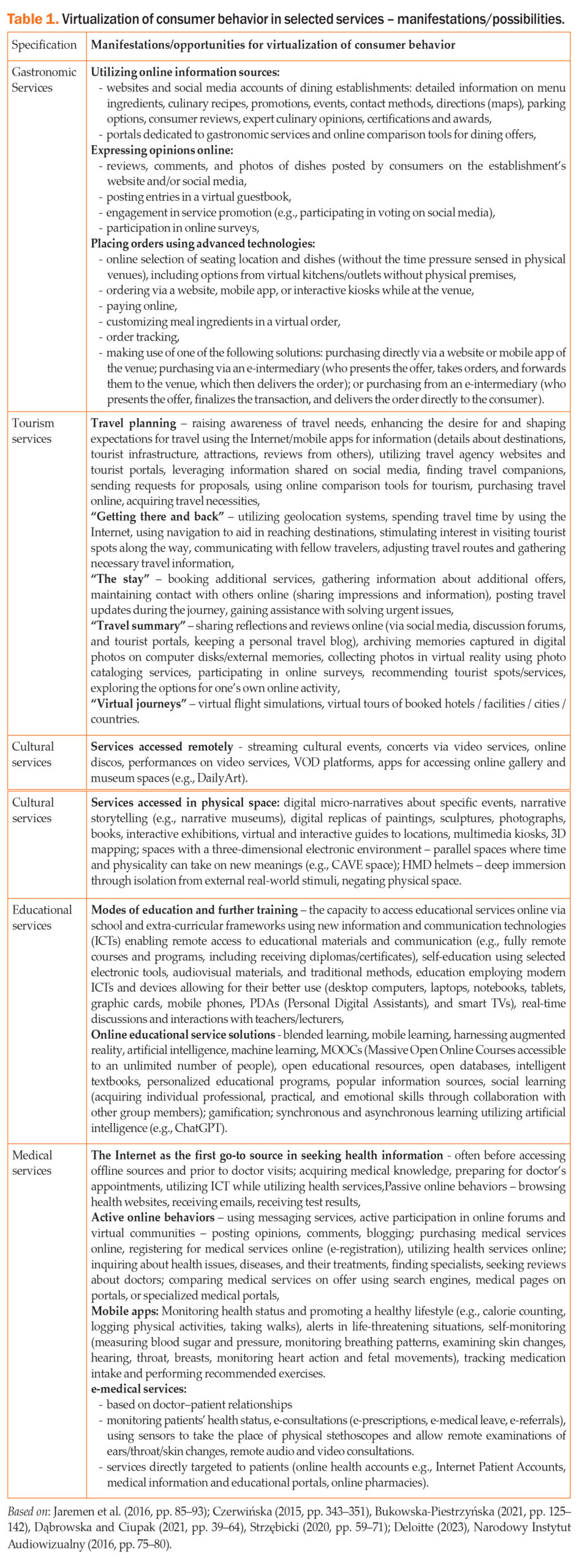
The virtualization of consumer behavior is a very dynamic phenomenon – increasing the range of behaviors transferred from the physical world to the virtual world or parallel behaviors that occur simultaneously in both physical and online spaces. Today’s service consumer is, indeed, a hybrid suspended between the real and virtual worlds (Gardeła & Budzanowska, 2002, pp. 14-17) thanks to nearly unlimited access to the Internet, the growing scale of ownership of devices that access virtual space, and the ongoing development of mobile applications.
Virtual and augmented-reality technologies create a new space for service consumer behaviors, particularly influencing the decision-making process (especially in terms of generating needs and evaluating alternatives) (Berbeka, 2016, pp. 92-95). They allow for the creation of new experiences and impressions and provide new stimuli, primarily visual. Their usefulness is manifested in consumers’ ability to acquire knowledge (about services, their prices, places of provision), advice (what needs to be taken care of), and suggestions resulting from monitoring of consumers’ lives (reminders of important events). These utilities make consumers better informed, better educated, and increasingly inseparably connected to these solutions – increasingly “plugged into” them (Berbeka, 2016, p. 88).
The virtualization of consumer behavior is manifested by the mutual permeation (rather than opposition) of the virtual (digital) and real (material) worlds (Ritzer, 2014, pp. 3-24; Kaczorowska-Spychalska, 2018, p. 190). The physical world known to the consumer is extended to include new virtual elements (augmented reality), while the digital reality is embellished with physical attributes (augmented virtuality) (Jaremen et al., 2016, pp. 55-67; Li, 2023, pp. 265, 276). The observed integration of real and virtual solutions should allow for the creation of frictionless experiences in the process of meeting service consumers’ needs (Kotler & Stigliano, 2022). This process should proceed according to their expectations – efficiently, dynamically, and continuously (PwC, 2022; Nowoczesne technologie, 2021, p. 61). The cost of learning to use modern solutions must be proportional to the benefits that consumers derive from their use. Technologies can also increase the personal engagement of staff and consumers, thereby supporting the creation of unique, personalized shopping experiences (enhancing “high-touch” through “high-tech”).
2.Online survey
To identify selected changes in the virtualization of consumer behavior in the Polish service sector during the pandemic, we carried out an online survey. The choice of this technique was guided by its undeniable advantages (e.g., speed of information acquisition, reach), although its limitations were also taken into account, such as the declarative nature of respondents’ answers (Pacana et al., 2015). The study was conducted in November 2022 using the Ariadna National Research Panel, with a sample of 1,100 registered participants. The socio-demographic profile of the registered panel members closely matched that of Polish Internet users. Data analysis was performed using descriptive statistical measures, employing IBM SPSS Statistics software.
The study was part of the research project entitled “COVID-19 Pandemic as a Catalyst for Change – Enterprise and Consumer Perspective”, conducted by the Department of Market and Consumption at the University of Economics in Katowice. The survey provided insights into:
- consumers’ opinions on the pandemic’s impact on various service sectors in Poland,
- solutions that consumers found helpful during the pandemic (mitigating/ alleviating pandemic-related difficulties) and their intentions to make use of these solutions in the future,
- opinions on the functioning of selected sectors after the introduction of pandemic-induced changes.
The study adopted the hypothesis that consumers highly valued the usefulness of virtual solutions in improving access to and use of services during the pandemic, but not all such conveniences would be eagerly used by consumers in the future (especially in the case of cultural services). We also assumed that the tourism, gastronomy, and cultural sectors were the most heavily impacted by the pandemic in this regard, but the solutions implemented by service companies to mitigate the negative effects of the pandemic helped maintain their operations at pre-pandemic levels.
The study sampled included 1,100 respondents, with almost equal numbers of women and men (Table 2). The sample included respondents evenly distributed across the age groups: 18–24, 25–39, 40–59, and 60–80 years (with 25% of respondents in each age group). Among the respondents, 46% had secondary education and nearly 40% had higher education, with primary education (4.1%) and vocational training (10.5%) being the least represented. Most respondents assessed their own financial situation as “adequate” (57%), with nearly 30% rating it as “very good” or “good”. Two-person households were the most common (33.4%), while households with five or more people were the least represented (11.5%).

The survey allowed us to identify consumers’ opinions on the impact of the pandemic on selected service sectors in Poland (Table 3). In the respondents’ view, the COVID-19 pandemic mainly entailed losses across all the sectors analyzed. The overall balance of benefits and losses caused by the pandemic in all the sectors studied was perceived as clearly negative by the respondents. Consumers believe that the pandemic particularly impacted the tourism, gastronomy, cultural, music, and fitness/spa sectors.

During the COVID-19 pandemic, companies implemented various solutions – some mandatory, others voluntary – aimed at helping consumers mitigate and alleviate pandemic-related challenges. These solutions primarily involved virtualizing access to and the use of the services analyzed. The results indicate that contactless use of parcel lockers and the ability to handle administrative matters online were seen by most respondents as effective in alleviating pandemic-related inconveniences. The majority of respondents also recognized that food delivery services to the home and “take-out” food orders, medical teleconsultations, and qualified electronic signatures had helped mitigate the difficulties of daily life during the pandemic. Fewer respondents, however, found virtual solutions such as online discos, video presentations of properties for purchase or rent, and streaming of theatrical performances or concerts to have been helpful during COVID-19 (Table 4).
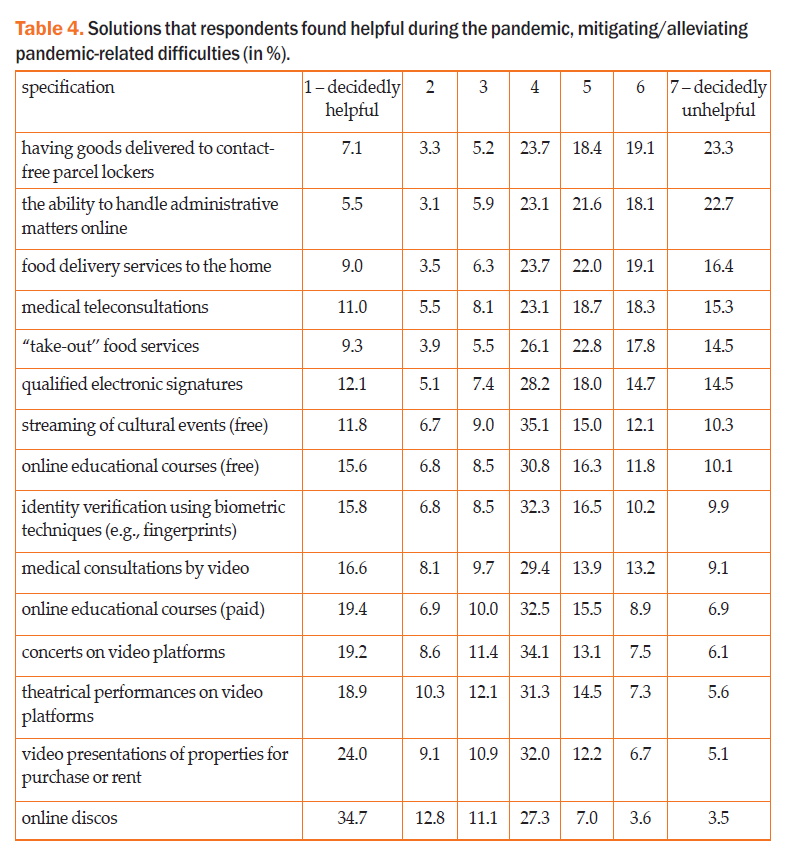
It was also interesting to explore how eager consumers would be to continue using new solutions developed during the pandemic once “normalcy” returned. The survey results (Table 5) indicate that the largest shares of respondents intended to continue to use online services for handling administrative matters, qualified electronic signatures, food delivery services to the home and “take-out,” as well as medical teleconsultations. Half of all respondents expressed the intention to make use of identity verification with biometric techniques (e.g., fingerprints) after the pandemic. However, significantly fewer consumers planned to continue using virtual solutions in the areas of cultural and educational services post-pandemic.
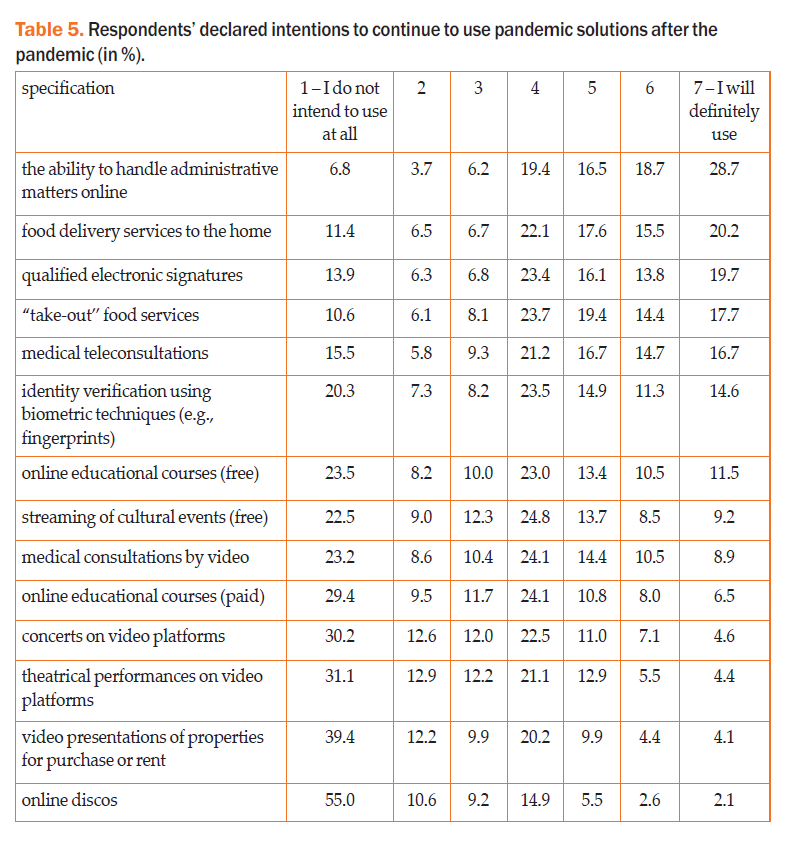
The survey also attempted to answer the question of how much the new solutions, enforced and stimulated by the pandemic, have changed the functioning of the sectors examined (whether they improved or worsened) (Table 6). Consumer opinions in this area indicate that the measures taken during the pandemic helped maintain the operations of these sectors at pre-pandemic levels – this is particularly true for the fitness/spa, cultural, entertainment, music, and transportation sectors. In consumers’ perceptions, innovative solutions contributed to better functioning, especially in the gastronomy sector. Only in the case of the medical sector did the majority of respondents feel that the introduction of new solutions had worsened its functioning.
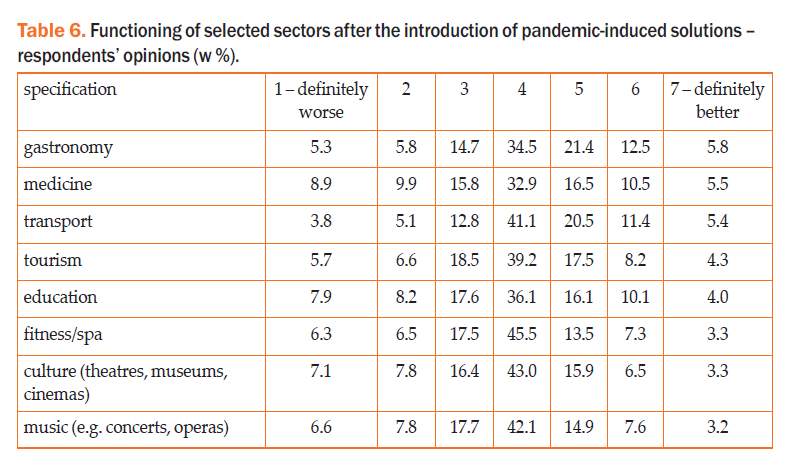
To address the question of how virtual solutions impacted the functioning of consumers and organizations during the pandemic, respondents were asked to express their opinions on selected statements related to this topic (Table 7). The vast majority of consumers acknowledged that the pandemic had led to the introduction of new solutions in commerce and services based on modern information technologies.
Most respondents also agreed that the pandemic increased consumer expectations for the option to have goods delivered to parcel lockers.
Additionally, the majority recognized that the COVID-19 situation enhanced consumers’ internet skills, such as online shopping, information searching, and handling administrative tasks. According to most respondents, the pandemic contributed to consumers adopting modern solutions in commerce and services. However, a smaller majority agreed that COVID-19 reduced the need for face-to-face interaction with sellers or service providers.
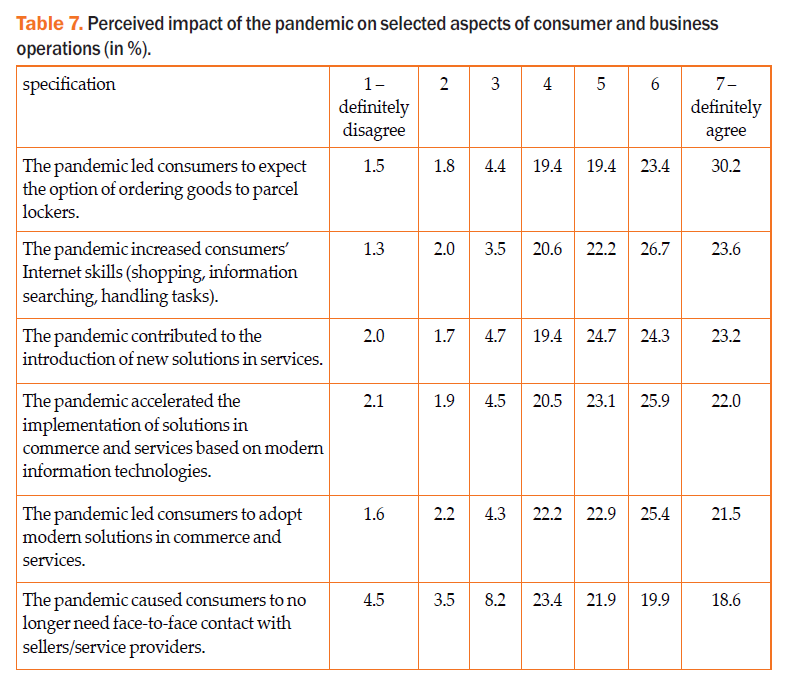
3. Summary
It is undeniable that the COVID-19 pandemic took everyone by surprise – consumers, households, as well as organizations, none of which had anticipated such a disruption in their operational plans. In this crisis, information and communication technologies (ICT) emerged as a crucial remedy, helping to mitigate the pandemic’s effects. The use of ICT increased on both the supply and demand sides. Virtualization became a key tool in alleviating the impact of pandemic-related restrictions, while also serving as a catalyst for changes driven by COVID-19, allowing operations to continue at levels close to those before the pandemic. Many of the conveniences introduced due to the pandemic are likely to persist in the “post-COVID” world. This paper has highlighted the pronounced shift towards virtual consumer behaviors in Poland’s service sector during the pandemic, with notable persistence in preferences for virtual interactions in administrative, food delivery, and telemedical services. These findings underscore the selective nature of consumer engagement with virtual solutions in the post-pandemic era.
The pandemic posed significant challenges for service providers, particularly due to the lack of physical interaction and the frequent need for direct involvement of staff and the physical presence of consumers. According to the survey respondents, COVID-19 caused losses across all the sectors analyzed, with the tourism, gastronomy, cultural, music, and fitness/spa sectors being the hardest hit. While the usefulness of virtual solutions during the pandemic is highly regarded by Polish consumers, not all of these solutions are expected to be used in the future, especially in the cultural sector. The measures taken during the pandemic did help maintain the functioning of sectors at pre-pandemic levels—this is particularly true for the fitness/spa, cultural, entertainment, music, and transportation sectors. In the gastronomy sector, these new solutions even contributed to better performance.
Service providers should consider these insights when designing their future service offerings. Given the selective continuation of virtual engagements, it is imperative for providers in cultural and gastronomic sectors to innovate and possibly hybridize their service delivery models to cater to the evolving preferences of consumers. The study also sheds light on the growing consumer expectations for seamless and flexible service interactions, whether virtual or physical. Providers need to strategize on how to blend these expectations into their operational models effectively.
The pandemic initiated and accelerated the adoption of new solutions in services and acted as a stimulus for implementing modern information technology solutions. It also led to an increase in consumers’ Internet skills (shopping, information searching, handling tasks) and encouraged the adoption of modern solutions in services. The pandemic accelerated the virtualization of consumer behavior in many services, and for most of the services studied, this process appears irreversible, particularly in light of ongoing technological and social changes. This presents significant challenges for service providers and institutions, both now and in the future.
Policymakers should consider these trends in virtual consumer behavior when formulating digital infrastructure policies, ensuring that the advancements in technology are equitably accessible and contribute positively to consumer experiences across all service sectors. Moreover, future research should explore the long-term impacts of pandemic-induced changes in consumer behavior, particularly analyzing the sustainability of these changes as technological advancements continue to evolve. It would also be beneficial to examine how different demographic segments adapt to and prefer various types of virtual services.
References
Ahmad, A. H., Masri, R., Chong, C. V., Fauzi, R. U. A., & Idris, I. (2020). Evolution of technology and consumer behavior: The unavoidable impacts. Evolution, 7(11), 2020.
Berbeka, J. (2016). Wirtualna i rozszerzona rzeczywistość a zachowania konsumentów [Virtual and augmented reality and consumer behavior]. Studia Ekonomiczne, 303, 84–101.
Bukowska-Piestrzyńska, A. (2021). Multikanałowość w ochronie zdrowia a e-zdrowie [Multichannel approach in healthcare and e-health]. In C. Mańkowski & L. Reszka (Eds.), Modelowanie procesów i systemów logistycznych (Vol. 22, pp. 125–146). Wydawnictwo Uniwersytetu Gdańskiego.
Bywalec, C. (2010). Konsumpcja a rozwój gospodarczy i społeczny [Consumption and economic and social development]. C.H. Beck.
Ciechomski, W. (2023). Contemporary consumer trends. Zeszyty Naukowe Politechniki Śląskiej. Organizacja i Zarządzanie, 173, 81–91. https://doi.org/10.29119/1641-3466.2023.173.6
Czerwińska, M. (2015). Specyfika zachowań e-pacjentów w Internecie [Specifics of e-patient behavior on the Internet]. Roczniki Kolegium Analiz Ekonomicznych/Szkoła Główna Handlowa, (38), 343–351.
Dąbrowska, A., & Ciupak, J. (2021). Changes in e-education brought by the COVID-19 pandemic in Poland: Behaviour and perceptions of young e-education service consumers and service providers. Marketing of Scientific and Research Organizations, 41(3), 39–64.
Deloitte. (2020). Jak będzie wyglądała nowa rzeczywistość COVID-19 [How the new reality of COVID-19 will look] [Brochure]. Deloitte Polska. https://www2.deloitte.com/content/dam/Deloitte/pl/Documents/Brochures/pl_jak_bedzie_wygladala_nowa_rzeczywistosc_COVID-19_2020.pdf
Deloitte. (2023, November 20). Jak COVID-19 zmienił nasze zwyczaje w korzystaniu z usług cyfrowych [How COVID-19 has changed our habits in using digital services]. Deloitte Polska. https://www2.deloitte.com/pl/pl/pages/technology-media-and-telecommunications/articles/jak-COVID-19-zmienil-nasze-zwyczaje-w-korzystaniu-z-uslug-cyfrowych.html
Dominiak, J. (2022). Wpływ pandemii COVID-19 na zmiany w sektorze usług w Polsce [Impact of the COVID-19 pandemic on changes in the services sector in Poland]. Prace Komisji Geografii Przemysłu Polskiego Towarzystwa Geograficznego, 36(2), 126–136.
Grybś-Kabocik, M. (2017). Wirtualizacja zachowań konsumentów a zrównoważona konsumpcja [Virtualization of consumer behavior and sustainable consumption]. Studia Ekonomiczne, (337), 164-173.
Jaremen, D., Michalska-Dudek, I., & Rapacz, A. (2016). Wirtualizacja zachowań konsumentów na rynku turystycznym jako źródło wiedzy w podejmowaniu decyzji marketingowych [Virtualization of consumer behavior in the tourism market as a source of knowledge in making marketing decisions]. Studia i Prace Wydziału Nauk Ekonomicznych i Zarządzania Uniwersytetu Szczecińskiego, (43/2).
Kaczorowska-Spychalska, D. (2018). Digital technologies in the process of virtualization of consumer behaviour–awareness of new technologies. Management, 22(2), 187-203.https://doi.org/10.2478/manment-2018-0031
Kotler, P., & Stigliano, G. (2023). Retail 4.0. 10 zasad handlu detalicznego w erze cyfrowej [Retail 4.0. 10 principles of retail trade in the digital era]. PWE.
Kowalska, M. (2015). Wpływ wirtualizacji zachowań konsumenckich na rozwój domocentryzmu [Impact of the virtualization of consumer behavior on the development of home-centeredness]. Handel Wewnętrzny, 359(6), 64-73.
Kowalska, M. (2023). Marketing relacji w dobie technologii cyfrowych. Narzędzie komunikacji online w kreowaniu relacji z klientami [Relationship marketing in the era of digital technology. Online communication tools in creating customer relationships]. Polskie Wydawnictwo Ekonomiczne.
Kucharska, B. (2015). Wirtualizacja zachowań nabywczych jako przejaw innowacyjności konsumentów w handlu detalicznym [Virtualization of purchasing behavior as a manifestation of consumer innovation in retail trade]. Marketing i Rynek, (10), 40-45.
Li, E. Y., Chang, F. K., & Jan, A. (2023). Understanding the virtual experiential value and its effect on travel intention. International Journal of Internet Marketing and Advertising, 19(3-4), 263-285. https://doi.org/10.1504/IJIMA.2023.133340
Mazurek-Łopacińska, K. (2021). Zachowania konsumentów na współczesnym rynku. Perspektywa marketingowa [Consumer behavior in the contemporary market. A marketing perspective]. Polskie Wydawnictwo Ekonomiczne.
Narodowy Instytut Audiowizualny. (2016). Użytkownik, zasoby, strategie. Instytucje kultury w środowisku cyfrowym [User, resources, strategies: Cultural institutions in the digital environment]. http://www.nina.gov.pl
Nowoczesne technologie w branży retail [Modern technologies in the retail industry]. (2021). Galerie Handlowe, 5(wrzesień-pażdziernik), 58-70.
Pacana, A., Ostasz, G., & Zatwarnicka-Madura, B. (2015). Dylematy wyboru metod badań marketingowych [Dilemmas of choosing marketing research methods]. Modern Management Review, 20(22/3), 171-181. https://doi:10.7862/rz.2015.mmr.43
Pluta-Olearnik, M. (2021). Usługi w nowej rzeczywistości z perspektywy dostawców usług i konsumentów. In W. Nowak, K. Szalonka, W. Kwaśnicki, G. Światowy, A. Niezgoda, I. Rudawska, & A. Niemczyk (Eds.), Zdrowie i Style Życia (pp. 125–138). Prawnicza i Ekonomiczna Biblioteka Cyfrowa. Wydział Prawa, Administracji i Ekonomii Uniwersytetu Wrocławskiego. http://doi.org/10.34616/142087
PwC. (2022, November). Frictionless retail – The future of shopping. https://www.pwc. co.uk/industries/documents/frictionless-retail-the-future-of-shopping.pdf
Ritzer, G. (2014). Prosumption: Evolution, revolution, or eternal return of the same? Journal of Consumer Culture, 14(1), 3-24. https://doi.org/10.1177/1469540513509641
Strzębicki, D. (2020). Rozwój sprzedaży posiłków przez Internet [Development of meal sales via the Internet]. Zeszyty Naukowe. Turystyka i Rekreacja, 1(25), 59-71.
Tarapata, J., & Krzepicka, A. (2018). Wirtualizacja zachowań konsumentów a zjawisko domocentryzmu [Virtualization of consumer consumersand home-centrism]. Nowoczesne Systemy Zarządzania. Modern Management Systems, 13(2), 93-106. https://doi.org/10.37055/nsz/129513
Urry, J. (2009). Socjologia mobilności [Sociology of Mobility]. Warszawa: PWN.
Włodarczyk, K. (2022). Zmiany w zachowaniach konsumenckich osób starszych w trakcie pandemii COVID-19 w świetle analizy trendów konsumenckich [Changes in the consumer behaviors of the elderly during the COVID-19 pandemic in light of consumer trend analysis]. Marketing i Rynek, (9), 3-14. https://doi.org/10.33226/1231-7853.2022.9.1
Zacher, L. (2013). Wirtualizacja – problemy, wyzwania, skutki [Virtualization – problems, challenges, effects]. Warszawa: Poltekst.
Zalega, T. (2017). Virtualisation of consumer behaviours of Polish seniors. Nierówności Społeczne a Wzrost Gospodarczy, (50), 256-275. https://doi.org/ 10.15584/nsawg.2017.2.16
Barbara Kucharska – Associate Professor at the Department of the Market and Consumption at the University of Economics in Katowice, Poland. Her scientific interests focus on the issues of retail, especially innovation in retail, and its impact on consumer behavior. Her research also concerns the issues of behavior of market entities in the context of sustainable development, virtualisation and the pandemic. She has carried out numerous research projects, both independently and in research teams. She is a member of the international research network ERECO-PGV.
Mirosława Malinowska – Assistant Professor at the Department of the Market and Consumption at the University of Economics in Katowice, Poland. Her scientific interests are connected with business communications, consumer behaviour, and innovations and new technologies in marketing. She has carried out numerous research projects, both independently and in research teams. She is a member of the international research network ERECO-PGV.

